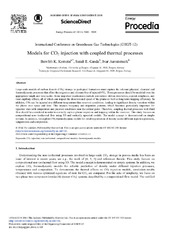International Conference on Greenhouse Gas Technologies (GHGT-12) Models for CO2 injection with coupled thermal proce
Peer reviewed, Journal article
Published version
Permanent lenke
https://hdl.handle.net/1956/10534Utgivelsesdato
2014Metadata
Vis full innførselSamlinger
Originalversjon
https://doi.org/10.1016/j.egypro.2014.11.329Sammendrag
Large-scale models of carbon dioxide (CO2) storage in geological formations must capture the relevant physical, chemical and thermodynamic processes that affect the migration and ultimate fate of injected CO2. These processes should be modeled over the appropriate length and time scales. Some important mechanisms include convection- driven dissolution, caprock roughness, and local capillary effects, all of which can impact the direction and speed of the plume as well as long-term trapping efficiency. In addition, CO2 can be injected at a different temperature than reservoir conditions, leading to significant density variation within the plume over space and time. This impacts buoyancy and migration patterns, which becomes particularly important for injection sites with temperature and pressure conditions near the critical point. Therefore, coupling thermal processes with fluid flow should be considered in order to correctly capture plume migration and trapping within the reservoir. This study focuses on compositional non- isothermal flow using 3D and vertically upscaled models. The model concept is demonstrated on simple systems. In addition, we explore CO2 thermodynamic models for reliable prediction of density under different injection pressures, temperatures and composition.

